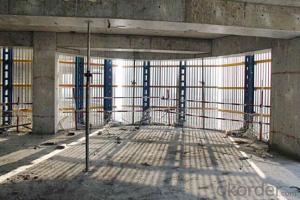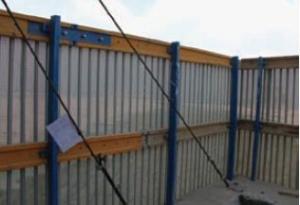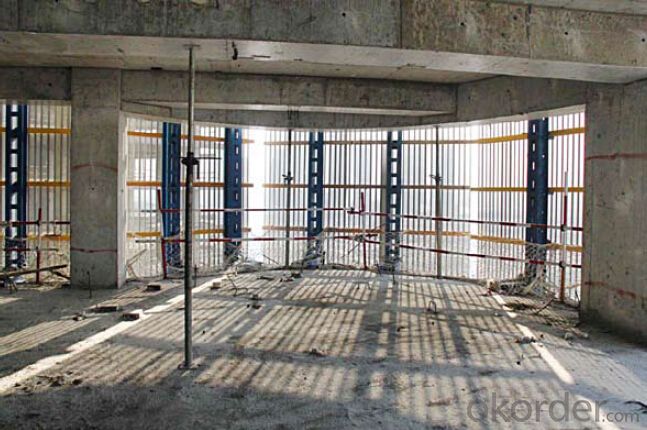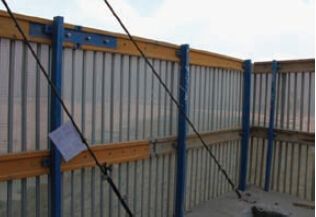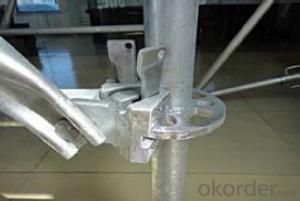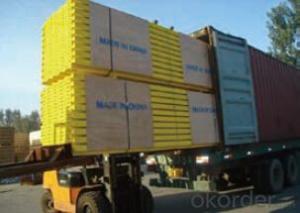Protection-Platform for Formwork and scaffolding system
- Loading Port:
- Tianjin
- Payment Terms:
- TT OR LC
- Min Order Qty:
- 50 m²
- Supply Capability:
- 1000 m²/month
OKorder Service Pledge
OKorder Financial Service
You Might Also Like
Protection Platform PP-50
A kind of new type construction protection system, applying operating platform and safer job
location for construction corps.
Characteristics:
◆ Easy and quick assembling.
◆ Lifted as a group, it is rapid and economic.
◆ Auto-climbing
◆ A safe and reliable anchor system
1. Composition
2. Assembly process of anchor system
(1) Embed V-climbing cone and anchor plate into the slab.
(2) Fix anchor shoe on the slab by tensile bolt.
(3) The fixed anchor shoe.
◆ High work efficiency with work platform and unload platform
◆ High light transmittance with the hollow block


- Q: Is steel formwork reusable?
- Yes, steel formwork is reusable. It is a durable and sturdy material that can be dismantled and used multiple times for different construction projects.
- Q: What is the maximum load that steel formwork can support?
- The maximum load that steel formwork can support depends on various factors such as the thickness and quality of the steel, the structural design and configuration of the formwork, and the supporting structure it is attached to. Generally, steel formwork is designed to withstand heavy loads and is commonly used for high-rise construction projects. However, it is essential to consult the manufacturer's specifications and engineering calculations to determine the specific maximum load capacity for a particular steel formwork system. Additionally, the maximum load capacity can also be influenced by the type of concrete being poured, the duration of the load, and any dynamic forces that may be present during construction. To ensure safety and structural integrity, it is recommended to engage a qualified engineer or structural designer who can assess the specific requirements of the construction project and provide accurate load capacity information for the steel formwork being used.
- Q: How does steel formwork affect the overall construction waste generation?
- Steel formwork can significantly reduce overall construction waste generation. Unlike traditional timber formwork, steel formwork is reusable, durable, and can be used for multiple construction projects. This means that less formwork material needs to be discarded and replaced after each use, reducing the amount of waste generated. Additionally, steel formwork is easier to clean and maintain, further reducing wastage. Overall, the use of steel formwork in construction projects helps minimize waste generation and promotes sustainable construction practices.
- Q: Are there any special considerations when using steel formwork in cold weather conditions?
- Yes, there are several special considerations when using steel formwork in cold weather conditions. Firstly, steel contracts and becomes more brittle in cold temperatures, which can increase the risk of cracks or fractures in the formwork. Therefore, it is important to ensure that the steel formwork is properly designed and reinforced to withstand the potential stress caused by temperature changes. Secondly, cold weather can also affect the curing process of concrete. Steel formwork tends to conduct heat away from the concrete, slowing down the curing process. This can result in insufficient strength development and compromised structural integrity. To mitigate this, additional measures may be required, such as using insulating materials or applying external heat sources to maintain optimal curing conditions. Furthermore, cold weather can also cause moisture to freeze on the surface of the steel formwork, leading to the formation of ice. Ice can increase the weight of the formwork and hinder the removal process. It can also cause damage to the formwork if not properly addressed. Therefore, it is essential to take preventive measures, such as using anti-freeze agents or providing adequate drainage to prevent ice buildup. Lastly, working in cold weather conditions can be challenging for construction workers. It is important to ensure that appropriate safety measures are in place, such as providing adequate insulation, heating facilities, and protective clothing to prevent workers from suffering from hypothermia or other cold-related illnesses. In conclusion, when using steel formwork in cold weather conditions, it is crucial to consider the increased risk of brittleness, the impact on concrete curing, the potential for ice formation, and the well-being of workers. By taking these special considerations into account, the use of steel formwork can still be efficient and effective in cold weather conditions.
- Q: What are the different types of finishes available for steel formwork?
- There are several different types of finishes available for steel formwork, each offering unique advantages and characteristics. Some of the most common finishes include: 1. Smooth finish: This is the most basic type of finish, where the steel formwork is left untreated. It provides a clean and smooth surface, making it suitable for applications where a smooth concrete finish is desired. 2. Galvanized finish: Galvanizing involves coating the steel formwork with a layer of zinc to protect it from corrosion. This finish is highly durable and can withstand harsh weather conditions, making it ideal for outdoor applications. 3. Powder-coated finish: Powder coating involves applying a dry powder to the steel formwork and then baking it on. This finish provides a decorative and durable coating that is resistant to chipping, scratching, and fading. It is available in a wide range of colors, allowing for customization. 4. Painted finish: Painting the steel formwork is another common option. It provides protection against corrosion and enhances the aesthetics of the formwork. Different types of paints, such as epoxy or acrylic, can be used depending on the specific requirements of the project. 5. Shot-blasted finish: Shot blasting involves projecting small steel shots onto the surface of the formwork at high velocity. This process removes any impurities, rust, or old coatings, resulting in a clean and textured finish. Shot blasting is commonly used when a rough surface is desired for better adhesion of the concrete. 6. Treated finish: Some steel formwork can be treated with special coatings or chemicals to enhance their properties. For example, anti-stick coatings can be applied to prevent concrete from adhering to the formwork, making it easier to remove after curing. Other treatments may include rust inhibitors or fire-resistant coatings. The choice of finish for steel formwork depends on various factors such as the intended use, environmental conditions, desired aesthetics, and budget. Consulting with a professional or manufacturer can help determine the most suitable finish for a specific project.
- Q: What are the different types of formwork accessories used with steel formwork?
- There are several different types of formwork accessories that are commonly used with steel formwork. These accessories are designed to enhance the functionality and efficiency of the formwork system, and to ensure the safety of workers during the construction process. 1. Formwork clamps: These are used to securely fasten the formwork panels together, ensuring that they remain in position and do not move during the pouring of concrete. Formwork clamps are available in various sizes and designs to accommodate different formwork systems. 2. Formwork props: These are adjustable steel props that are used to support the formwork panels vertically. They provide stability and load-bearing capacity to the formwork system, making it safe for workers to operate on. 3. Formwork ties: These are used to hold the formwork panels firmly in place and prevent them from bulging or deflecting under the weight of the concrete. Formwork ties are typically made of steel and are available in different lengths and designs to suit the specific requirements of the construction project. 4. Formwork connectors: These are used to connect formwork panels together at corners or joints, ensuring a tight and secure fit. Formwork connectors come in various shapes and sizes, such as corner connectors, wedge connectors, and pin connectors. 5. Formwork brackets: These are used to support the formwork panels horizontally, providing additional stability and reinforcement. Formwork brackets are commonly used in beam and slab construction, where the formwork needs to be supported over a long span. 6. Formwork release agents: These are chemical substances that are applied to the formwork surface to prevent the adhesion of concrete. By using release agents, the formwork can be easily removed after the concrete has cured, allowing for efficient and smooth formwork removal. Overall, these formwork accessories play a critical role in ensuring the success of a steel formwork system. They provide the necessary support, stability, and reinforcement to the formwork panels, allowing for the efficient and safe construction of concrete structures.
- Q: Can steel formwork be used for both large and small construction projects?
- Yes, steel formwork can be used for both large and small construction projects. Steel formwork is highly versatile and can be adjusted to fit various project sizes. It offers durability, strength, and stability, making it suitable for both small-scale and large-scale construction projects.
- Q: Can steel formwork be used for architectural concrete beams?
- Yes, steel formwork can be used for architectural concrete beams. Steel formwork offers several advantages over traditional wooden formwork, such as increased durability and reusability. Steel formwork is stronger and more rigid, allowing for precise and accurate construction of architectural concrete beams. It also provides a smooth and consistent surface finish, which is important for achieving the desired aesthetic appearance of the beams. Additionally, steel formwork can be easily assembled, disassembled, and transported, making it a practical choice for architectural concrete beam construction.
- Q: Can steel formwork be used for high-rise construction projects?
- Indeed, high-rise construction projects can indeed utilize steel formwork. Renowned for its robustness and resilience, steel formwork is ideally suited for demanding tasks like high-rise construction. It furnishes exceptional steadiness and reinforcement to the concrete throughout the pouring and solidifying stages, guaranteeing the building's structural soundness. Moreover, steel formwork can be swiftly assembled and disassembled, making it highly efficient for constructing tall edifices that encompass multiple floors. Furthermore, its reusable characteristic facilitates long-term cost savings. In summary, steel formwork is an esteemed and widespread preference for high-rise construction endeavors.
- Q: How does steel formwork handle different concrete pumping methods?
- Steel formwork is highly versatile and can handle different concrete pumping methods with ease. The rigid and sturdy nature of steel formwork allows it to withstand the pressure and force exerted by various pumping techniques such as boom pumps, line pumps, and even placing concrete by gravity. Additionally, the smooth surface of steel formwork ensures that the concrete flows smoothly during the pumping process, resulting in a consistent and high-quality finish. Overall, steel formwork is well-suited for accommodating different concrete pumping methods and ensuring efficient and successful construction projects.
Send your message to us
Protection-Platform for Formwork and scaffolding system
- Loading Port:
- Tianjin
- Payment Terms:
- TT OR LC
- Min Order Qty:
- 50 m²
- Supply Capability:
- 1000 m²/month
OKorder Service Pledge
OKorder Financial Service
Similar products
Hot products
Hot Searches
Related keywords
